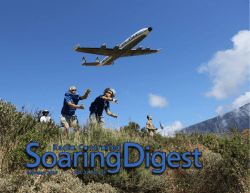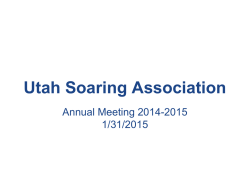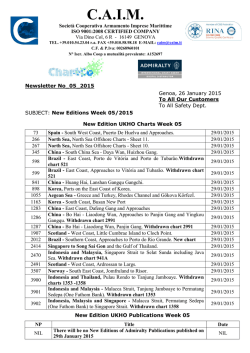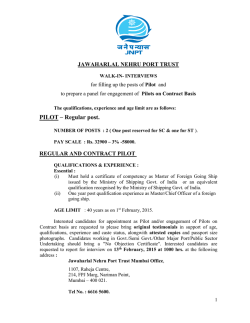
Current - Skyline Soaring Club
M O N T H LY N E W S L E T T E R O F S K Y L I N E S O A R I N G C L U B , I N C FEBRUARY 2015 S KY LI N ES Masthead photo: Dick Otis From the President John Noss M y thanks to everybody for a great turnout at the annual membership meeting, we had a good showing even with the marginal weather forecast. If you didn’t make the meeting, please find the pdf version of the slides in the membersonly section of the club website documents, and catch up on what we covered. If you have questions about some of the discussions, ask anybody who was there. Congratulations to the two board members elected at the meeting, Ertan Tete (for a second term), and Dan Ernst. Many profound thanks to outgoing board member Jim Kellett, who finishes up two terms (six years) on top of 5 years back in ’95-’99, and has been our Secretary and resident repository of club corporate knowledge. Keith Hilton volunteered to take over as the new Secretary, please say thanks when you see him for taking on another thankless job. Looks like I will also continue one more year as your President, my second term on the board expires next year. (If you haven’t read the By-Laws, board members are elected for 3-year terms, and a maximum of two consecutive terms, and the secretary and president positions are selected by the board.) Even with the recent snow and more expected soon, we managed two very nice ad-hoc flying days in January, with 40 flights total, the most we have flown in January except for 2008 (and that was with incredibly mild weather and 4 flying days). It was helpful that we got to keep some of our students proficient, there are a 1 handful chomping at the bit to knock out a checkride soon. Congratulations to young Gabrielle Buffaloe on her award of this year’s SSEF scholarship, she already has 6 flights with the club and is off to a strong start. I look forward to seeing everybody at the mandatory annual safety meeting, 1030L , 21 February at the Samuels Library in Front Royal (same location as the membership meeting). Fly Safe, Fly Often, Have Fun! Photo: Kaye Ebelt 2015 Membership Meeting B Photo: Martin Gomez Photo: Piet Barber y now everyone has seen the pdf John circulated. The high resolution version is online at the Members Only: restricted Docs location. It is an outstanding, multi-faceted, informative breakdown of every aspect of Club operations. We all owe a huge thank you to all concerned in putting together such an outstanding document. 2 Above: Hats Off Awards to Keith Hilton, Bob Sallada, Steve Rockwood, Piet Barber, Jim Kellett, Steve Zaboji. Far Right: DO of the Year Steve Rockwell receives his “Hats Off” award. Right: George Hazelrigg presents the SSEF Soaring Flight Education Scholarship to Gabrielle Baffaloe. Below: Spencer Annear, Martin Gomez, Shane Neitzey and new SSC secretary Keith Hilton share with the members. Photos: Martin Gomez, Kaye Ebelt 3 Flutter, Phugoid and Sometimes Slips Happen T = 2 π / (g/CLV) (2 CL2 - CD2 )1/2 Kaye Ebelt W hen George Hazelrigg offered an advanced CFI course for Skyline Soaring Club members, it was filled almost immediately. George graciously opened up his home to ten eager students and devoted his time to make the class worthwhile and challenging to private pilots. “We will cover the FARs, aerodynamics, flight instruments, navigation, flight and cross-country planning, weather, and other glider-peculiar stuff,” said George. “There is homework including reading assignments and tests that will result with students being signed off to take the FAA knowledge test for the PPL-G or CPL-G.” However, George warned, “ I do not teach merely to pass the test. I teach to impart an in-depth understanding of all relevant topics.” Each week the students are assigned a topic to teach. They prepare lesson plans that would be appropriate for an 8th grade student. During class, the students then teach their lessons while the class critques it for acuracy. “It’s not as easy as I thought it Photos from Kaye Ebelt Above right: JIm Garrison, above George Hazelrigg and right Keith Hilton demonstrate different types of performance assesment. Below: Ertan Tete, Chris Zaboji, Kaye Ebelt, Vern Kline, George Hazelrigg, Jim Garrison, Rob Creedon, Joe LIngevitch and Clark Lunkford. (not pictured Carlos Troncoso) would be to take simple aerodynamics and gear it to an 8th grade level,” said Rob Creedon. After a thorough lesson on flutter, Jim Garrison concluded, “You can flutter to your phugoid but be careful cause slip happens.” One of the strenghths of the class is having the opportunity to focus on the all the required aviation topics of assessment, including different types of performance assessment that put the focus on learning, take advantage of the eachother’s expertise, and evaluate deeper learning. With two classes remaining the students are looking forward to sharing their lessons with future student pilots. Thank you to George for sharing your aerospace engineering and aviation experise with us. Do Drop Inn Robert Gray R ecently Hugh McElrath landed his hang glider in the safety area. We were all standing around open mouthed in amazement. Then someone asked me if we should send the 4-wheeler to tow and I said no, just run and grab the hang glider. In hind sight I realized that my reaction was way too slow because I had not thought about what to do ahead of time. What should we do if a hang glider or paraglider or even a hot air balloon lands on the grass at FRR? I think we should put instructions in the Ops manual. Then members will think about it ahead of time. I wrote the following suggestion with help from Hugh McElrath. Hang Glider Landing: Alert approaching gliders/power planes that NORDO unpowered ultralights are over the airport. One to four club members should get in position in the Safety Area to assist the hang glider pilot while the hang glider is on the downwind pattern. Bring a radio. Do NOT bring a tow vehicle. They should stay to the side (in the ditch?) out of the way during final approach. Then they should move in to help as soon as the glider flies past. In windy conditions someone needs to get hold of the nose of the wing as soon as possible. The first person should grab the nose wires and hold the nose level into the wind. Hold the nose wires high enough so the wing still gets some lift-this takes weight off the pilot and helps him carry the glider. The next two should grab the wing tips. The fourth should ask the pilot if he wants help with the harness or holding the keel or down tubes. Ask the pilot if he wants to get out of the harness before moving the glider. If the pilot is injured or too tired, an experienced member should take control of the down tubes. Place your shoulder muscles between the down tubes and wrap your arms back to front around the down tubes. Do not let the down tubes rest on the arm bone below the shoulder muscles, or you will get badly bruised. Coordinate with the person holding the nose wires to walk/fly the glider to a safe position. The glider should be moved to the taxiway side of the Safety Area, maybe into the ditch, and then up to the picnic tables for disassembly. The idea is to keep the glider nose into the wind and walk sideways or backwards to the breakdown area, with someone holding the nose wires to fly the glider with the wind just lifting the weight of the glider. Move the glider to the lee/downwind side of the terminal. Wingtip assistance is a big help. Park the glider tail-to or quartering the wind. Help dis-assemble the glider as directed by the pilot. If the wind is so strong that the glider is getting uncontrollable, it is possible to disconnect the nose wires and fold the control frame so the wing is flat on the ground and break it down in that position. Nice action sequence (photos courtesy of my friend Ellis Kim) of launching in strong breeze (high teens) from the newly rock-crushed and graded luxurious gravel ramp. Went 24 miles to Waynesboro, landed in a farmer’s pasture. He told me I had to have a burger ‘cause it was such a good story to say I had just dropped in for one.—Hugh McElrath Paraglider Landing: A paraglider pilot should be able to disable and ball up his wing unassisted; but if he gets in trouble and is getting dragged, grab one wingtip and get the glider turned athwart the wind to disable it and deflate it. Try not to step on the lines-you could break or rip one or more out. Do not move an injured pilot. Ask the DO call 911. Ask the pilot how you can help. Secure the glider or paraglider so that it does not move or injure the pilot. You can disconnect the glider from the harness at the carabiners; someone may have to carry the balled up glider inside out of the wind to keep it from blowing away. The pilot may have broken bones. A pilot with a broken neck or back must not be moved at all. Ask the pilot if he can feel and move his toes. Wait for the 911 paramedics to move the pilot. In crash landings, hang glider pilots typically break collar bones, while paraglider pilots typically break lower vertebrae. Hot Air Balloon: Grab onto the basket and ask the pilot what help is needed. If possible, move the basket and balloon clear of the safety landing area, following the pilot’s directions. Ask the pilot if the Gator would be useful. Photo: Phil Jordani Student Pilots Studied Weather Forecasts & Skew-T Charts to Predict Soaring Weather Kaye Ebelt W hat is density altitude? Why should you get a weather briefing and weather information from DUATS? What type of clouds indicated possible good soaring conditions? Those were some of the questions posed at a recent weather forecasting lesson for Skyline Soaring Club student pilots. While the student pilots can safely fly a glider, collecting and analyzing weather data can be foreign territory. This was the motivation behind inviting Club member John Noss to share his expertise with seven student pilots seeking to improve their aviation weather knowledge in preparation for upcoming glider private pilot checkrides. A morning session covered the practical test standards for gliders in the area of weather and the afternoon included a discussion on skew-T charts. After reviewing notes related to weather, that previous student pilots had shared after their checkrides, John threw out questions for everybody to answer. If they didn’t know the answer, they had to look them up as might be expected on a checkride in real time. John gave students the opportunity to Photos from Kaye Ebelt demonstrate their knowledge or seek further explanation. For the afternoon, John presented a PowerPoint package (with pdf version) that showed examples of actual Skew-T charts and local weather reports with photos of the skies taken from his back deck. Typically, the environmental temperature, dew point temperature, wind speed and wind direction at various pressure levels are plotted on the skew-T chart, the most commonly used thermodynamic diagram within the United States. Since the class, John has continued to provide students with resources to expand their weather and soaring knowledge. Michael Bishton commented, “I’m very appreciative of John sharing his knowledge with us.” Evan Dosik said thank-you to John for “…your generous sharing of your knowledge and time to help us grow as safe pilots.” The confidence in obtaining, analyzing and making sound decisions soared that day. Tim Moran said, “I found this class to be very helpful in preparing for my flights.” “The knowledge John imparted us with will certainly help with the checkride but ultimately be used every time we fly”, said the author. Left: Michael Bishton, John Noss, Chris Carswell, Mario Simula, Kaye Ebelt. Below: Michael Bishton, Mario Simula, Chris Carswell, Bill Vickland, Tim Moran, Evan Dosik, John Noss. Timely reminder from Bob Gould: KFRR’s AWOS is now available online at: http://w1.weather.gov/obhistory/KFRR.html. 6 Update from An Old Friend with my job and writing. I have been busy working for a inertial systems and sensors company Memsic. I have finished writing a AHRS (Attitude Heading Rate System) and am most of the way through a GPS / INS fusion system and have a inertial vario that I have been working on in my spare time. I have also written and published a fiction novel and am working on a book on programming embedded Internet Of Things type systems. I have not been flying as I am still recovering from the expense of moving back to the bay area and have been very busy A primer on originality . . . here’s what was important to soaring in the United States according to a guest editorial by Ted Nelson in the in May/June, 1949 issue of SOARING magazine: “Power for Soaring” T he soaring fraternity has labored unceasingly to bring soaring to a position of national importance in the realm of sport. That the objective has not yet been attained is obvious. It certainly has not been due to lack of effort but rather to the operational methods requisite for soaring flight using conventional glider equipment, and to some extent the promotional approach to the American sportsmen. There are, of course, many solutions to these problems. One of these is the powered sailplane. The powered sailplane has long been neglected as a possible vehicle for the promotion of soaring flight. Preoccupation with design refinement of present sailplanes, lack of suitable power plants and scarcity of funds have undoubtedly restricted the development of such powered sailplanes. Today soaring needs such a craft if it is to reach its goal. Briefly, here is why. First, the approach to the American sportsman must emphasize the enjoyment that soaring has to offer rather than the specialized skill it requires. The average American sportsman is far more content to enjoy his sport and would much prefer to leave the stiff competition to the professionals and the more adept. The popularity of skiing, boating and such bears out this statements. That participation in popular sports be convenient is also a must. The powered sailplane fills this requirement easily. Second, the present need for special airports and soaring sites for gliding and soaring flight must be eliminated except for special competitive flying. The side utilization existing airports is imperative. Unfortunately many airport operators do not approve of glider activity as a permanent adjunct. Recent operations with powered sailplanes, however, have encountered no serious objection from airport operators. 7 The following is a synopsis of my novel: “Through the Pillars of Hercules” How does the world make the leap to the ultra high tech worlds in sci fi? It has been proposed that the Black Death was at least partially responsible for the start of the Renaissance. What happens when one of the architects of the capital of high tech teams up with a couple of teens and long lost friends to escape a crisis that Malthus reminds us happens every time we exceed the ability of the planet to sustain our numbers? Dan Vogel is a pilot of airplanes and gliders that leads an unlikely group out of an urban battle ground to a place that just could be the one good thing to come of the worst crisis since the original “Black Death”. Jen Beauchamp is an early teen that is wise beyond her years determined to turn any setbacks into an advantage to step into the life that she has been preparing for since she was born. Joe diPicolo is a mid teen with more attitude than skills that quickly learns that when stuff hits the fan if you don’t adapt quickly you get left behind. Douglas Hiranaka Former Skyliner, partner in TO, one time Skylines editor Third, the problem of student instruction cannot be overlooked in any realistic approach to the development of soaring. The present operational methods are too slow, cause too much delay for rapid instruction and are contingent upon good soaring weather for lo cost operation. The powered sailplane can effectively operate with no time lost for towing, lack of soaring weather and the like. Landing techniques and instruction methods are comparable to conventional airplane practices. Weak thermal conditions that cannot sustain flight in conventional gliders can be utilized to demonstrate soaring techniques in a powered sailplane. Fourth the operational cost both for school instruction and pleasure flying can be kept to a minimum with a powered sailplane. This is predicated on the supposition that new lower-cost designs will be forthcoming. The development of powered sailplanes has been slow. Only a very few experimental craft have been built and all were modified from existing equipment. Foreign development has been little better. However, we have recently produced two craft designed specifically as powered sailplanes, namely the Nelson “Dragonfly” an the “Humming Bird”. The former is the first craft to by type certificated a a powered glider by the CAA. These ships, it is realized, are not the ultimate in such designs but are felt to be a step in the right direction. Let’s see more of them developed.”—Jim Kellett Photo: MIchael Bishton Photo by Mike Peterson VASA Instructor Summit 2015 Piet Barber T he Virginia Soaring Association had a meeting in mid-January 2015. All of the soaring instructors for the soaring clubs in Virginia were invited to this meeting, where we discussed how we approached flight instruction, scheduling, and a variety of other topics. The meeting was organized by Jim Kellett and Jim Garrison, and was hosted in Charlottesville, at a classroom in the University of Virginia Medical center. The meeting had participants from Tidewater Soaring Society, Blue Ridge Soaring Society, Shenandoah Valley Soaring, Merlin Soaring, and Skyline Soaring Club. Charles Norman, John Noss, Jim Garrison, Martin Walker, Jim Kellett and Piet Barber represented Skyline Soaring during this meeting. Topics discussed included a short 10 minute presentation on the ways we instruct as different clubs, how we approached scheduling and planning for instruction. We also discussed the topics of difficult students, and difficult instructors. John Molumphry gave a presentation on some of the failures that he’s seen during practical test check rides, and some tips on how to improve the preparation of the candidates for their check rides. The meeting also discussed the VASA Survey results. Jenn Player of TSS created a survey asking the students for all the different flying clubs in Virginia various questions about the quality and consistency of the flight instruction of these clubs. Over 100 students across the state of Virginia responded to the survey. One of the final presentations was from Hal Loken of Shenan- Potomac TRACON: Operation Rain Check Kaye Ebelt S kyline Soaring Club was well represented at the Potomac TRACON event on January 10th. The FAA Safety Team (FAASTeam) were committed to providing a meaningful event. The event was open to pilots and their guests. During the two hour event, team members were on hand to answer questions of the FAA management, controllers, FSDO, flight service and security elements. After the briefing and Q & A portion, attendees toured the ATC Facility, the 3rd busiest approach control facility in the United States. They listened to actual ATC traffic and 8 doah Soaring. He found a piece of land southwest of Charlottesville that is large, flat, and wide enough to be suitable for a soaring operation with a winch. He’s looking for a team of investors to make it a reality. Left to right: Two Skylines friends whose names nobody knows and Steve Rockwood, Robert Gray, Paul Sekada, Keith Hilton, Chris Zaboji, Ertan Tete, Evan Dosik, Kaye Ebelt (Not pictured Ted Stewart and Hugh McElrath). Photo essay from Kaye Ebelt spent some time in the ATC traffic simulation room. Training efficiency is the key concern in controllers training. The ATC traffic simulation room was designed to expose trainees to a wide range of operational situations, the frequent as well as the exceptional ones. Part of ATC training includes psychical endurance evaluations. Trainees need to develop appropriate habits created through exercises on emergencies and failures that rarely occur in real traffic. The time the Club members spent in the simulation room exposed us to the fully integrated tools for training preparation, execution and evaluation. Pilots enrolled in the FAA WINGS programs were given a credit for participation in this safety program. Recycled Information Worth Repeating SAY AGAIN Dear SSA Members—Recently, the SSA changed email distribution companies. Due to security measures, the new company will not allow us to send eNews to anyone who has not responded. There was an email asking to click a link and respond immediately. This is a legitimate email request from SSA. Please respond by clicking the link “Confirm to list: The Soaring Society of America” below the message box. This has to be done by you personally. This is a one-time sign up. Please add iContact to your list of safe mailers. This will be the last email sent using Constant Contact. The rest of eNews will come from iContact. If you have deleted the email please let me know so that I can send it again. We want all of our members to continue receiving eNews so please respond at your earliest convenience to insure that you do not miss out on any future issues of eNews. If you have already clicked the link please disregard this email. Also if you do not want to receive eNews please disregard both emails. My apologies that the original email looked suspiciously like SPAM, but it is not. It is a valid email and the link to click is safe. Thanks for supporting the SSA and eNews. Sincerely, Kayla Owens The Soaring Society of America www.ssa.org 575-392-1177 Some of us have debated to merits of ballistic recovery systems, but there is no doubt they have saved many lives. In this case I am not sure I would describe it as some headlines have, that the pilot successfully ditched his airplane. He yanked the handle which is under a thin cover in the ceiling of the Cirrus. As with all BRS deployments, it is worthwhile to review how the pilot got to the point that he needed it.—Steve Wallace http://www.cnn.com/videos/us/2015/01/26/vo-pilot-emergencyescape.u-s-coast-guard President—John Noss Secretary—Keith Hilton Treasurer—Steve Rockwood Membership—Steve Rockwood Chief Duty Officer—Craig Bendorf Chief Tow Pilot—Martin Gomez Skyline Soaring Club, Inc. Chief Flight Instructor—Piet Barber is a private, 501(c7) non-profit organization, Safety Officer—Charles Norman dedicated to the enjoyment and promotion of the sport of soaring. SSC is based at Skylines Editor—Phil Jordan the Front Royal-Warren County, Va. Airport [email protected] and is an affiliate club of the Soaring Society of America. Directors—John Noss, Ertan Tete, For information about the club go to Martin Gomez, Richard Garrity, www.skylinesoaring.org Keith Hilton, Dan Ernst 10 Progress report on one heck of an imaginative creation: here’s a few photos of the marvelous Shane’s Illudium Q-36 glider “fright” simulator (a 2-33 never looked so good!) from Shane and Kaye Ebelt Thank you Bruce Zivic, Charles Norman for paint prep and Val Neitzey for striping off the mask. Beta testing by the Pros—we might even get Kellett in the back-seat of a 2-33 this way!
© Copyright 2026







